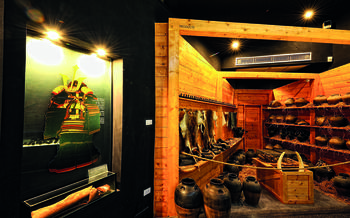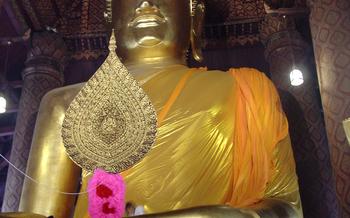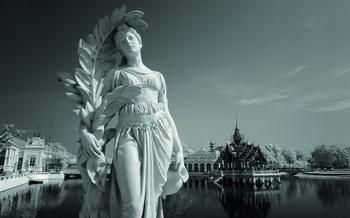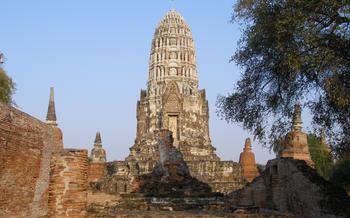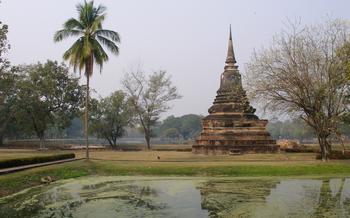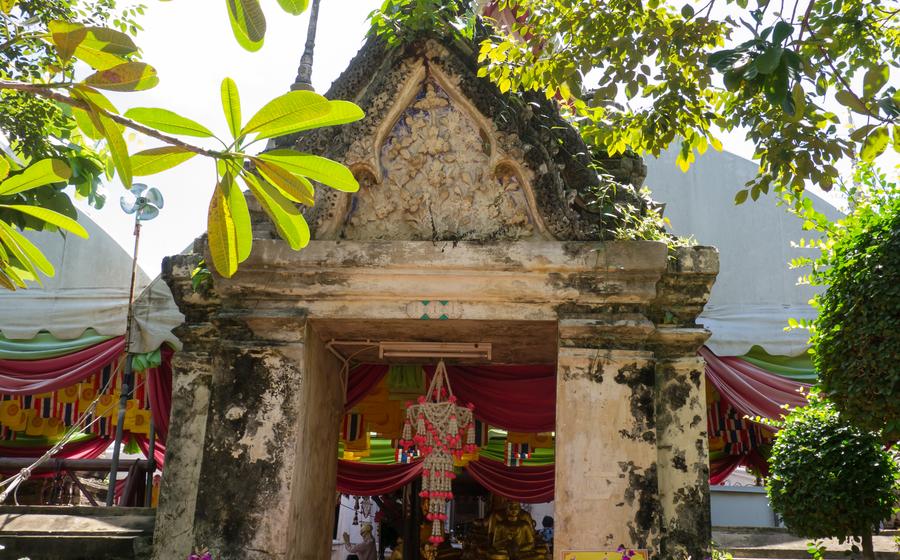
Wat Tha Karong
- The Ruins of Wat Tha Karong: A Historical Overview
- Exploring the Temple Grounds: What to See
- The Ordination Hall: A Place of Spiritual Significance
- The Reclining Buddha: A Symbol of Peace and Tranquility
- The Royal Connections: A Link to Thailand's Monarchy
- Restoration Efforts: Preserving a National Treasure
- Visiting Wat Tha Karong: Practical Information
- Guided Tours: Enhancing Your Experience
- Photography Opportunities: Capturing the Temple's Beauty
- Nearby Attractions: Exploring Ayutthaya's Treasures
- Accommodations: Finding a Place to Stay
- Transportation Options: Getting Around Ayutthaya
- Local Cuisine: Tantalizing Thai Flavors
- Insider Tip: Discovering Hidden Gems
The Ruins of Wat Tha Karong: A Historical Overview
Wat Tha Karong, nestled in the heart of Ayutthaya Historical Park, stands as a testament to Thailand's rich cultural heritage. Built in the 15th century during the reign of King Borommatrailokkanat, the temple served as a significant religious and educational center for centuries. Its unique architectural features, including the iconic reclining Buddha image, intricate carvings, and ancient stupas, have earned it a place among the most visited temples in Ayutthaya.
Legends surround the temple's construction, adding to its mystique. According to one legend, the temple was built by a group of monks who were shipwrecked on the shores of Ayutthaya. They vowed to construct a temple as an offering to Buddha for saving their lives, and Wat Tha Karong was born. Another legend attributes the temple's construction to a wealthy merchant who wished to honor his deceased wife. Regardless of its origins, Wat Tha Karong remains a symbol of faith, resilience, and the enduring power of Buddhism in Thailand.
Exploring the Temple Grounds: What to See
As you wander through the temple grounds, you'll be greeted by a myriad of Buddha images, each exuding a unique aura of serenity and spirituality. These statues, crafted with intricate detail, represent various mudras (hand gestures) and postures, each holding symbolic significance in Buddhist teachings. The serene expressions on the faces of these Buddhas seem to emanate a profound sense of peace and tranquility, inviting you to pause and reflect on the teachings of the Buddha.
In addition to the Buddha images, the temple is adorned with a wealth of intricate carvings and sculptures that showcase the exceptional craftsmanship of Ayutthaya's artisans. These intricate embellishments, often depicting mythical creatures and scenes from Buddhist mythology, add a layer of visual interest and depth to the temple's architecture. The walls, pillars, and lintels are adorned with a symphony of carvings, each narrating a story from the Buddhist scriptures or showcasing the rich cultural heritage of Thailand.
Amidst the temple complex, you'll also encounter several ancient stupas, which are bell-shaped structures that hold a profound religious significance in Buddhism. These stupas represent the enlightened mind of the Buddha and serve as a reminder of his teachings on the path to liberation from suffering. The stupas at Wat Tha Karong vary in size and design, each embodying a unique aspect of Buddhist philosophy and serving as an object of veneration for devotees.
The Ordination Hall: A Place of Spiritual Significance
The ordination hall, also known as the ubosot, is the most sacred building within the temple complex. It is here that monks are ordained and important Buddhist ceremonies are held. The hall is a large, rectangular structure with a high, steeply pitched roof. The exterior is decorated with intricate carvings and sculptures, while the interior is adorned with exquisite murals depicting Buddhist teachings.
The murals inside the ordination hall are a masterpiece of Thai art. They cover the walls and ceiling and tell the story of the Buddha's life and teachings. The murals are incredibly detailed and lifelike, and they provide a valuable insight into Buddhist culture and beliefs.
The ordination hall is a place of great spiritual significance for Buddhists. It is a place where they can come to pray, meditate, and learn about the Buddha's teachings. The hall is also a place where important ceremonies are held, such as ordinations and weddings.
The Reclining Buddha: A Symbol of Peace and Tranquility
Among the many treasures of Wat Tha Karong, the reclining Buddha stands out as a symbol of peace and tranquility. Carved from a single block of sandstone, this colossal image exudes an aura of serenity that invites contemplation and reflection. Its sheer size is awe-inspiring, measuring an impressive 42 meters in length and 8 meters in height. The Buddha is depicted in the "parinirvana" pose, representing the moment of his passing into eternal bliss. The intricate details of the sculpture, from the serene facial expression to the gracefully folded hands, showcase the exceptional artistry of the ancient craftsmen.
The reclining Buddha at Wat Tha Karong is not only a masterpiece of art but also a source of spiritual inspiration. Its presence creates a palpable sense of calm and tranquility, inviting visitors to slow down, let go of their worries, and immerse themselves in the moment. Whether you choose to sit in silent meditation before the Buddha or simply admire its beauty from afar, this iconic image will leave a lasting impression on your soul.
The Royal Connections: A Link to Thailand's Monarchy
Wat Tha Karong's historical significance extends beyond its architectural and religious importance, as it also holds a deep connection to Thailand's monarchy. The temple has been under the patronage of the royal family for centuries, and this connection is evident in several ways.
One of the most notable royal connections is the use of the temple for royal ceremonies and events. In the past, the temple has been used for royal ordinations, cremations, and other important ceremonies. Even today, the temple is occasionally used for royal events, such as merit-making ceremonies and religious festivals.
Another indication of the royal patronage of Wat Tha Karong is the presence of several Buddha images that have been donated by members of the royal family. These Buddha images are often made of precious materials, such as gold or silver, and are considered to be highly sacred.
The ongoing royal support for the preservation of Wat Tha Karong is evident in the fact that the temple has been designated as a royal temple. This designation means that the temple receives regular financial support from the royal family, which is used to maintain and restore the temple's structures and grounds.
Restoration Efforts: Preserving a National Treasure
Wat Tha Karong's historical significance and architectural beauty have made it a national treasure worthy of preservation. Over the years, the temple has undergone several restoration projects aimed at maintaining its integrity and safeguarding its cultural heritage.
The restoration efforts have faced various challenges, including the effects of time, weather, and natural disasters. The temple's structures have been subjected to the wear and tear of centuries, and the delicate murals and carvings have suffered from the elements. Additionally, past renovations have sometimes used inappropriate materials or techniques, leading to further deterioration.
Despite these challenges, local communities and conservation organizations have played a vital role in preserving Wat Tha Karong. They have worked tirelessly to raise awareness about the temple's importance and secured funding for restoration projects. Skilled artisans and craftsmen have employed traditional techniques to repair and restore the temple's structures, murals, and sculptures, ensuring that its original beauty and historical significance are preserved for future generations.
Visiting Wat Tha Karong: Practical Information
Location and Accessibility: Wat Tha Karong is situated in the Bang Pa-in district, approximately 20 kilometers south of Ayutthaya city. The temple is easily accessible by road, with well-paved roads leading to its entrance. Visitors can opt to drive their own vehicles or hire a taxi for a convenient and comfortable journey. Alternatively, public transportation is also available, with buses and minivans departing regularly from Ayutthaya city center to Bang Pa-in.
Opening Hours and Admission Fees: Wat Tha Karong welcomes visitors from 8:00 AM to 5:00 PM daily. The temple is open to the public free of charge, allowing travelers to explore its grounds and marvel at its architectural wonders without any financial burden.
Dress Code and Temple Etiquette: When visiting Wat Tha Karong, it is essential to adhere to the temple's dress code and etiquette. Visitors are expected to dress respectfully, covering their shoulders and knees. Removing shoes is required before entering the temple's sacred spaces, including the ordination hall and the area surrounding the reclining Buddha. It is also considered polite to maintain a quiet and respectful demeanor while exploring the temple grounds, preserving the serene atmosphere for both visitors and worshippers.
Guided Tours: Enhancing Your Experience
Exploring Wat Tha Karong with a knowledgeable guide can greatly enhance your experience. Guided tours provide insightful commentary on the temple's history, architecture, and religious significance, allowing you to delve deeper into its stories. These tours often point out hidden details and lesser-known facts that you might miss on your own.
Several reputable tour operators offer guided tours of Wat Tha Karong. These tours typically last for about an hour and cover the temple's main highlights, including the ordination hall, the reclining Buddha, and the intricate carvings. Some tours also include visits to other nearby temples and historical sites, providing a comprehensive overview of Ayutthaya's rich cultural heritage.
The cost of guided tours varies depending on the tour operator, the duration of the tour, and the number of participants. It is advisable to book your tour in advance, especially during peak tourist season, to avoid disappointment. Online booking platforms and local travel agencies can assist you in finding the best tour options that suit your interests and budget.
Photography Opportunities: Capturing the Temple's Beauty
Wat Tha Karong's captivating architecture, intricate carvings, and serene atmosphere present a treasure trove of photographic opportunities. To capture the temple's grandeur, arrive early in the morning or late in the afternoon when the soft, golden light illuminates the structures, casting long shadows that accentuate the temple's intricate details. Explore different angles to find unique perspectives, such as shooting from a low angle to emphasize the towering stupas or capturing the reflection of the temple in the surrounding ponds. Remember to respect the sanctity of the temple and avoid using flash photography, especially when photographing the Buddha images. Embrace the opportunity to document this historical site and share its beauty with the world.
Nearby Attractions: Exploring Ayutthaya's Treasures
In addition to Wat Tha Karong, Ayutthaya offers a wealth of other historical and cultural attractions that beckon travelers to explore the city's rich past. A short walk from Wat Tha Karong, visitors can discover the majestic Wat Mahathat, renowned for its iconic Buddha head entwined by the roots of a bodhi tree. Another must-visit site is the grand Wat Phra Si Sanphet, the former royal temple that once housed the Emerald Buddha. For a glimpse into Ayutthaya's vibrant local life, head to the bustling floating market, where vendors offer a variety of local delicacies and handicrafts. History enthusiasts can delve deeper into the past at the Ayutthaya Historical Park, a UNESCO World Heritage Site that encompasses a vast collection of ancient ruins and temples. Whether you prefer exploring ancient temples, delving into local culture, or savoring delectable Thai cuisine, Ayutthaya offers a diverse range of experiences that will captivate and enrich your journey through this captivating city.
Accommodations: Finding a Place to Stay
When planning your visit to Wat Tha Karong, choosing the right accommodation is essential. Several hotels and guesthouses in Ayutthaya offer a range of options to suit different budgets and preferences.
For a truly immersive experience, consider staying in the historic district of Ayutthaya. This charming area is home to many guesthouses and boutique hotels housed in beautifully restored traditional Thai houses. These accommodations often offer a unique glimpse into the city's rich history and culture.
If you're on a budget, there are several affordable guesthouses and hostels located within walking distance of Wat Tha Karong. These options provide basic but comfortable accommodations at a fraction of the cost of luxury hotels.
No matter your budget or preferences, finding a place to stay in Ayutthaya is easy. The city has a wide range of accommodation options to suit every traveler's needs.
Insider Tip:
For a truly unique experience, consider staying at a homestay in Ayutthaya. This is a great way to immerse yourself in Thai culture and learn about the local way of life. Many homestays in Ayutthaya offer comfortable accommodations and delicious home-cooked meals.
Transportation Options: Getting Around Ayutthaya
Navigating Ayutthaya is a breeze with the diverse transportation options available. Public transportation, including buses and taxis, offers a convenient and affordable way to get around the city. Buses are a great option for exploring the main attractions, while taxis provide a more personalized experience.
For those who prefer a more active mode of transportation, renting a bicycle or motorbike is a fantastic way to explore the city at your own pace. Cycling allows you to soak in the sights and sounds of Ayutthaya, while a motorbike offers more freedom and flexibility.
Ride-sharing apps like Grab and Bolt are also widely available in Ayutthaya, providing a convenient and cost-effective way to get around. These apps offer a variety of vehicle options, from budget-friendly sedans to comfortable SUVs.
No matter which mode of transportation you choose, getting around Ayutthaya is easy and convenient. So, hop on a bus, hail a taxi, rent a bike, or download a ride-sharing app, and start exploring this enchanting city.
Local Cuisine: Tantalizing Thai Flavors
Ayutthaya's culinary scene is a vibrant tapestry of flavors, aromas, and colors. From street food stalls to renowned restaurants, the city offers a delectable array of dishes that will tantalize your taste buds.
Must-Try Dishes:
- Pad Thai: A stir-fried rice noodle dish with shrimp, chicken, or tofu, tossed in a sweet and tangy tamarind sauce.
- Khao Soi: A northern Thai curry noodle soup with rich coconut milk broth, egg noodles, and your choice of protein.
- Som Tum: A spicy green papaya salad with tomatoes, garlic, chili peppers, and peanuts.
- Gaeng Daeng: A red curry with bamboo shoots, bell peppers, and your choice of meat or tofu.
- Khao Neeo Mamuang: Sweet sticky rice with ripe mango, a popular dessert in Thailand.
Street Food Delights:
Ayutthaya's street food scene is not to be missed. From grilled meats and seafood to noodle soups and tropical fruits, there's something for every palate. Be sure to try the local favorites like Moo Ping (grilled pork skewers), Som Tum (green papaya salad), and Roti Sai Mai (sweet roti with condensed milk).
Cooking Classes and Culinary Experiences:
If you're passionate about Thai cuisine, consider taking a cooking class in Ayutthaya. Learn the art of preparing authentic Thai dishes from local chefs and immerse yourself in the vibrant flavors of Thai culinary culture.
Insider Tip: Discovering Hidden Gems
Beyond the renowned temples and attractions, Ayutthaya is home to hidden gems that offer a glimpse into its rich history and local culture. For an authentic experience, venture off the beaten path to explore lesser-known temples and ruins scattered throughout the city. These hidden treasures often provide a serene and intimate atmosphere, free from the crowds of tourists.
Attend local festivals and events to immerse yourself in the vibrant Thai culture. These celebrations showcase traditional music, dance performances, and local delicacies, offering a unique opportunity to interact with the friendly people of Ayutthaya. Engage with locals, learn about their way of life, and gain insights into their beliefs and customs.
